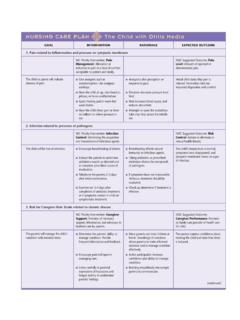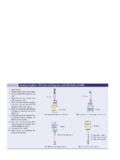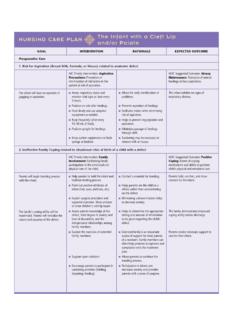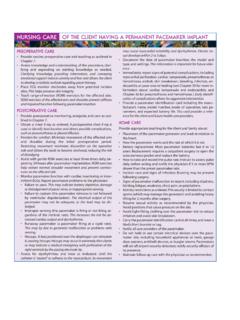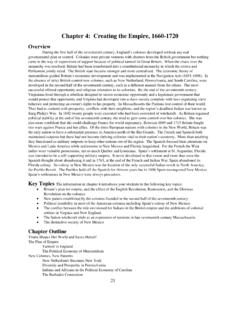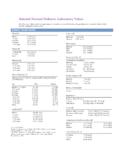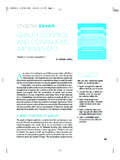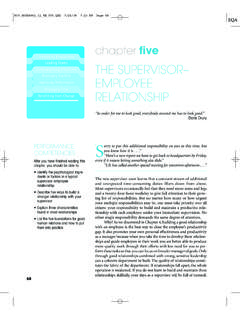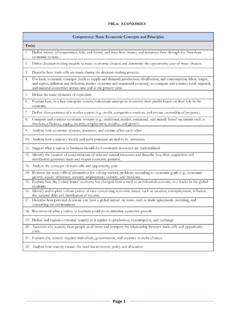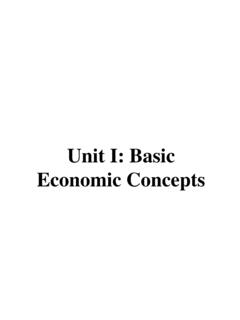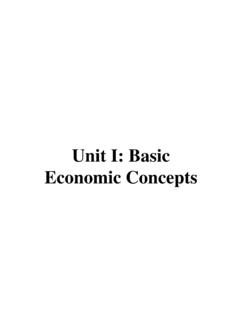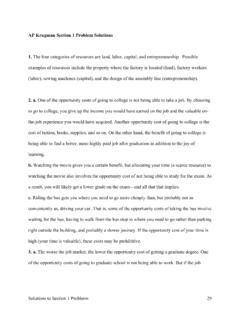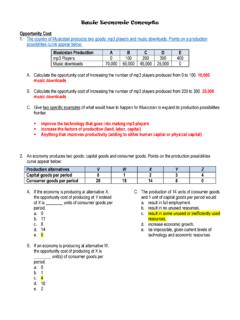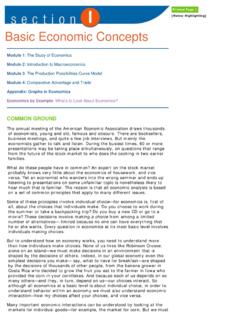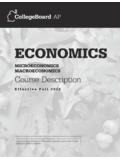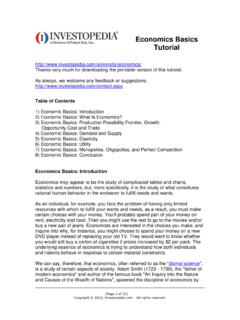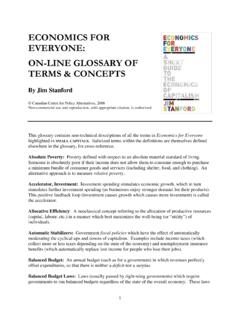Transcription of Introduction to Basic Economics Concepts
1 APPENDIXI ntroduction to BasicEconomics ConceptsThis appendix serves as a verybrief overview of some of the main economicsconcepts used throughout this book. If the reader has had an introductory orintermediate Economics course before this (and the book aims at such a stu-dent), this material should serve as a quick reminder of the Basic the student who has never encountered economic thinking before, pleaseremember that entire books and one- to two-semester courses usually coverthe material that follows, and judge the adequacy of the coverage of thismaterial found here with concept OF UTILITY AND DEMAND CURVESE conomists begin their study of human behavior by making what somewould consider a rash assumption, namely that every consumer has a stableset of preferences that allows comparison of different bundles of goods(taken here very broadly to mean goods and services produced in the marketor activities that might take place out of the market).
2 These preferences arenormally represented as a utility function showing how additional amountsof each good increase total well-being or (in the usual term) utility. Econo-mists normally presume that goods continue to add utility as more areconsumed, so sometimes the good becomes the removal of a noxious sub-stance. For example, garbage removalmay be the good rather than list of possible goods is very large. Think about how many bar codes existfor all the stores in the world; each one describes a different good and this 1/15/09 12:40 PM Page 571572 APPENDIX Introduction TO Basic Economics Concepts misses items such as watching a sunset for which no bar code (yet) simplify the discussion, we usually abstract from the specific names ofthese goods and simply call them etc. Thus, the utility functionbecomes where Nis the number of goods thatone might possibly wish to consider.
3 For reasons of simplicity includingour ability to diagram these Concepts readily economists often collapse thediscussion to two goods (which can then be pictured on a two-dimensionalgraph, as you will see shortly). This actually does not cause a great loss of pre-cision in thinking because these two goods can be one specific good (such aspopcorn or peanuts) and the other a composite bundle of all other goodsand thinking rests fundamentally on the premise that consumersmake choices to maximize their utility, limited by the amounts of goods thatthe consumer s income can purchase. In more elaborate versions of thisproblem, income itself represents choices made by the consumer in the cur-rent period (how much to work versus how much to enjoy leisure) as well asthe cumulative effects of many past decisions (how much education to seek,how hard to study in classes of health Economics , how much to save for thefuture).
4 We assume that consumers not only know their preferences but alsohow to act to maximize their own utility. Although few economists believethat this literally occurs in every human choice, a very fruitful study ofhuman behavior emerges from this simple yet powerful types of decisions can be portrayed easily either in graphs or byusing the branch of mathematics known as Basic problem ofthe consumer is to maximize utility subject to a budget constraint,2and thiscan be easily portrayed (in a simplified version) in a two-dimensional this graph, we focus on a specific good (say,) and choices between thatgood and all othergoods. Figure shows two key features about how goodsaffect utility. First, for any specified amount ofadding more adds tototal utility but at a decreasing rate. This conforms to the simple idea that weeventually become sated in our consumption of a specific good.
5 The for-mal statement of this says that we have positive but diminishing marginal(or incremental) utility for any specific good such as (The same is ,X1 Utility=U1X1, X2, XN2X1, X2, 1A classic discussion of these issues is found in Milton Friedman s Essays in Positive Economics (1966).2 This type of problem commonly uses an approach devised by mathematician Joseph-LouisLagrange, known (not by coincidence) as Lagrange is usually consideredto be French, but he was born in Turin, Italy, and wrote his famous essay on finding maximaand minima in 1755 in Italian at age 19, probably younger than almost every reader of thistextbook! (What had youdone by age 19?) 1/15/09 12:40 PM Page 572 THE concept OF UTILITY AND DEMAND CURVES573 UtilityX1U1U2X1fX1eX1cX1dX1bX1aDE FABCX other = 10 Xother = 9 Xother = 8(a)X1 XotherX1aABCU1 DEFU2(b)FIGURE for because it represents a bundle of all other goods andservices.)
6 Indeed, any one of those could be pulled out and treated similarly to) The other key feature of Figure (a) shows that similarly shapedcurves exist for each possible level ofbut utility is lower as the amountoffalls so that these curves nest one under another as the amount comes an important step: We take the information from the curvesin Figure (a) and transform the same information into a different graph,one using and on the axes. (This is why we want to work only withtwo goods. Otherwise this becomes an n-dimensional graph that s difficult ifnot impossible to draw for ) To see how this works, pick a specific levelof utility in Figure (a) (say,), and think about the combinations ofand that could create exactly Figure (a) shows three possiblelevels ofarbitrarily designated as 8, 9, and 10 (but they could be any-thing because we haven t said in what units is measured).
7 Points A, B,and Call have exactly the same level of utility but each has a differentcombination ofand The graph of those points (and all others likethem if we d drawn more curves in Figure (a) for different amounts of) creates an isoutility curveat utility level in Figure (b).3 Morecommonly, economists call these indifference curvesbecause the consumer isliterally indifferent to which of any combination of goods on each curve ,XotherXother, , come from the Greek word isosmeaning equal. 1/15/09 12:40 PM Page 573574 APPENDIX Introduction TO Basic Economics Concepts best to D, E,and Ffrom Figure (a) translate into a sepa-rate indifference curve in Figure (b). We could create an extremelylarge number of such curves in Figure (b) (an infinite number of them,actually) by picking specific levels of utility in Figure (a) and graphing therelevant points over to Figure (b).
8 We usually draw only a few of suchcurves to symbolize the overall idea, and (as you will see in a moment), onlyone of them eventually matters the highest one achievable with the budgetavailable to the curves are really no different than many maps you ve often maps, for example, either with curves or colors, show areas of thecountry with the same temperature. Meteorologists call these isothermalmaps, meaning same temperature. Topographical maps show lines of con-stant altitude, and anybody who s ever used these maps soon becomes able tolook at them and figure out what the terrain that the map depicts looks next step allows us to move from the ephemeral world of utility(which we can t really see or measure) to the concrete world of prices andquantities. Begin with (and slightly generalize) the graph in Figure (b)and then think about how to add information about the consumer s buyingpower, the budget available to buy goods and services.
9 In the simplestmodel, the consumer s income (I) is fixed at a specific level (say,). InFigure (a), this income appears as a downward-sloping straight line with aslope determined by the relative prices ofand .5 The trick is to findthe highest possible level of utility (remember that the consumer is trying tomaximize utility within the constraint of the budget available), and it s easyXotherX1I1U24A personal note: The word indifferenthas a specific meaning to economists not universallyshared by others. It refers to combinations of things that create the same utility. Early in mymarriage, my wife would sometimes ask me, Do you want peas or corn with the meat loaftonight? Because I d just learned the concept of indifference in an Economics class, I wouldrespond I m indifferent, meaning either would be fine. Before I explained this conceptclearly, she heard instead I don t want either as my message, and this came close to ruiningour marriage until I explained the underlying economic idea to her.
10 I can now say I m indif-ferent without having to call a marriage show why the budget line is a straight and downward-sloping line in this graph, begin withthe notion that all available income is spent on goods and purchased at prices of(for ) and (arbitrarily) a price of 1 for other goods. Thus Now we askwhat combinations of goods could exactly consume the total budget do this, increase by a little bit and ask how much has to fall to keep within the budget. Adding one unit ofcauses spending to increase by so the amount ofhas to fall by exactly to keeptotal spending the same. The constant-budget line in the graph with and on the axesthus has a slope ofMore generally, in a graph ofversus the budget line will havea slope of- ,Xi-1 ,X1 XotherX1I=p1X1+ 1/15/09 12:40 PM Page 574 THE concept OF UTILITY AND DEMAND CURVES575to see that one does this by finding the highest possible indifference curvethat just touches the budget constraint at one point.

